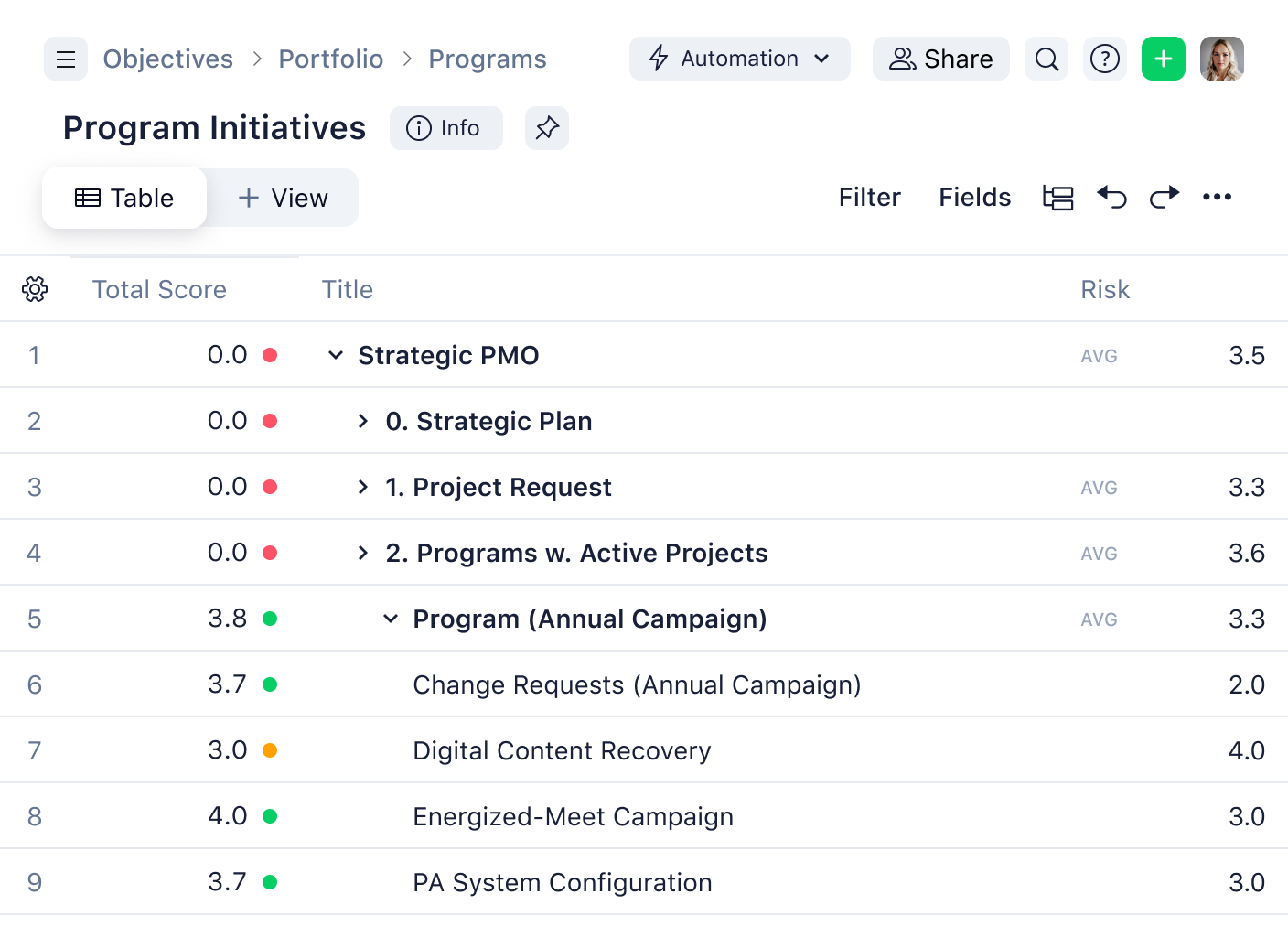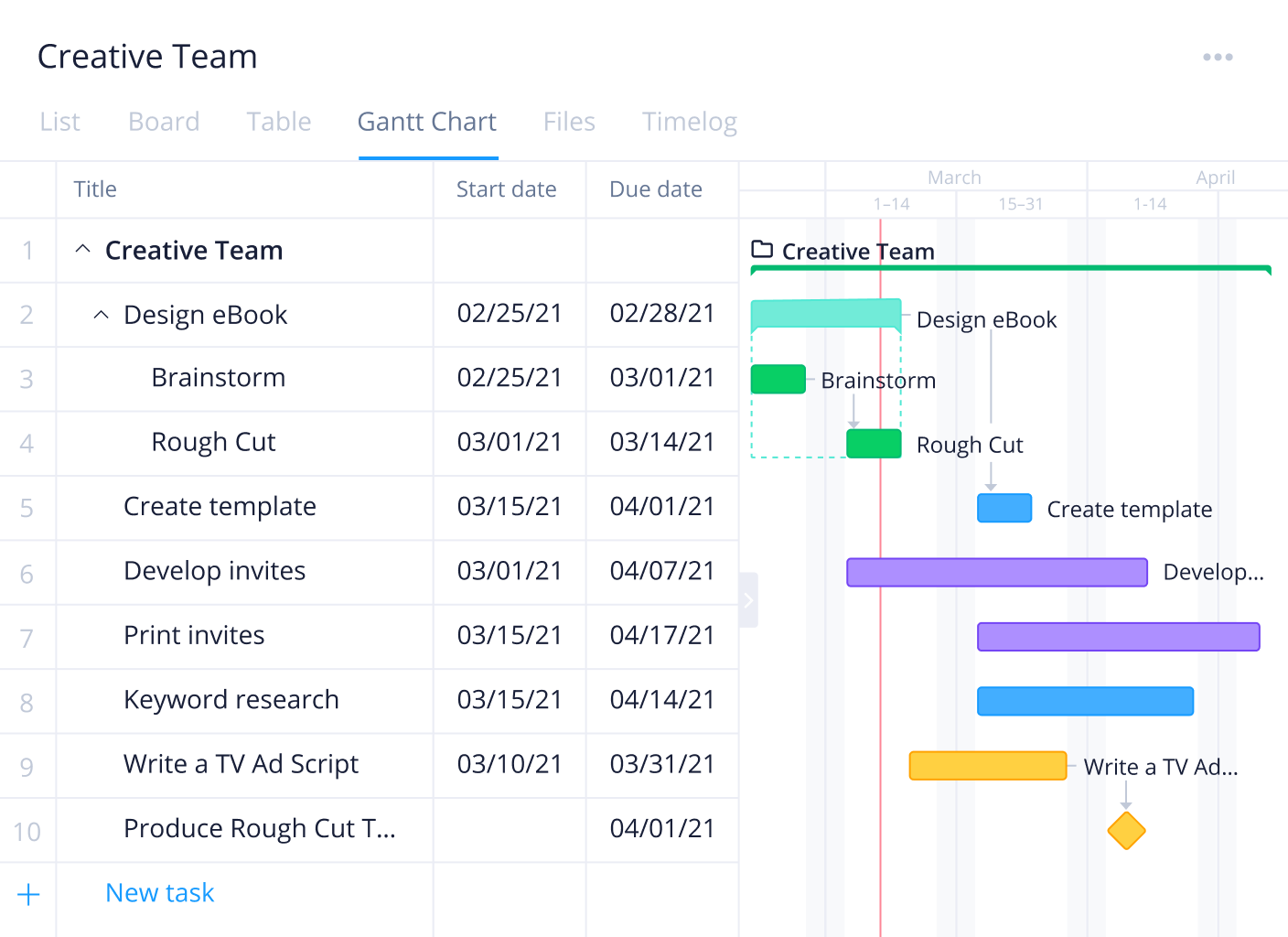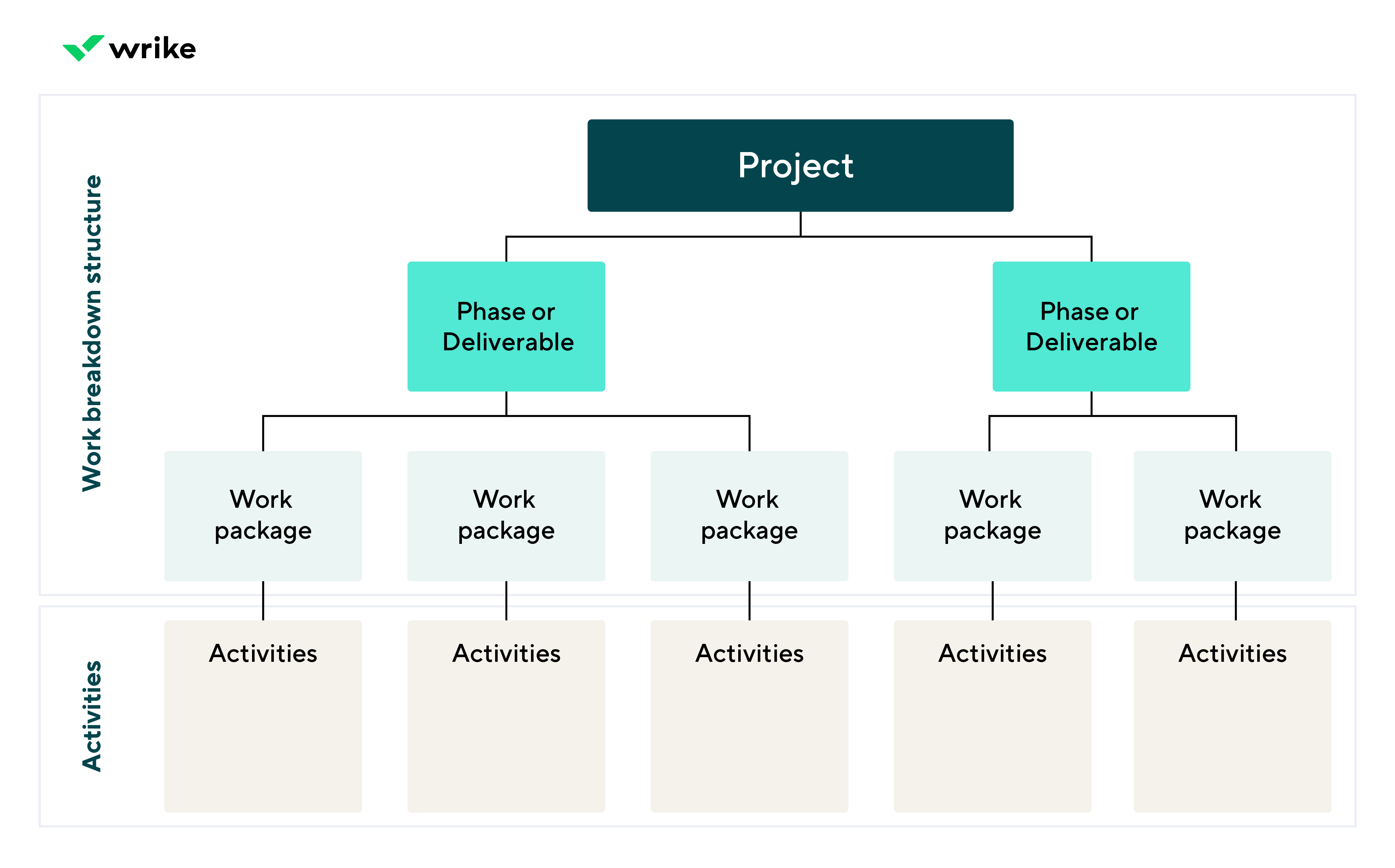What Is Work Breakdown Structure in Project Management?
What is WBS in project management?
Work breakdown structure (WBS) in project management is a method for completing a complex, multistep project. Within a larger project plan, it’s a way to divide and conquer large projects to get things done faster and more efficiently.
In this FAQ article, we’ll go over:
- What is a WBS in project management?
- Why it’s helpful
- How to create a WBS
- What characteristics are important
We’ll also offer a thorough example of work breakdown structure, which you can use as a base for your own WBS.
Using Wrike, you can build a WBS quickly and easily by creating folders and subfolders. Plus, you can go further and divide individual tasks into subtasks. Or, to ease the process entirely, you can simply use our prebuilt WBS template to help you jump-start the WBS process.
First, let’s define a project work breakdown structure more precisely.

Video transcription
Sometimes, the most critical parts of project management can seem really complicated. That’s why we’re explaining important project management concepts in a way that’s easy to understand and put into practice. Today, we’re tackling how to create a work breakdown structure. Here’s how the Project Management Institute defines it: a work breakdown structure is a deliverable-oriented hierarchical decomposition of the work to be executed by the project team to accomplish the project objectives and create the required deliverables. I wasn’t joking — work breakdown structure sounds complicated, but let’s break down work breakdown structure in simple terms. A work breakdown structure is a way to divide and conquer large projects to make them more manageable. A work breakdown structure breaks a project into smaller chunks so each team member can complete their assigned chunk simultaneously. It’s a method that can make your team more productive and successful at project management.
Now we’re getting somewhere, right? So let’s talk about how you can create a work breakdown structure for your own projects. There are a few steps you’ll need to complete to get started. First, assess the project scope by talking to all the stakeholders and key team members involved. Gather all critical input and deliverables for your project into a single location. Prioritize these deliverables using a list, spreadsheet, Gantt chart, or flowchart. You need to understand what elements are most important and the order of completion. Create a work breakdown structure and assign accountability to your team members to get the project done, making sure you spread the responsibility across your whole team.
Here’s what a work breakdown structure might look like for a project. You’re able to easily see all of the tasks, work packages, and activities that work together to make your project a success. In Wrike, you can build a work breakdown structure by creating folders and subfolders. You’ll create a folder for your project, then a subfolder for each phase or deliverable that has associated tasks and activities. Finally, you can go even further to divide individual tasks into subtasks with Wrike. You can assign tasks and subtasks to your team in just a few clicks so each person knows what they’re responsible for, how their tasks relate to the overall project, and when their work is due. Creating your work breakdown structure can be complicated but, with the right tools, it doesn’t have to be.
What does WBS mean?
The Project Management Institute’s project management body of knowledge book (PMBOK) defines WBS as “a deliverable-oriented hierarchical decomposition of the work to be executed by the project team to accomplish the project objectives and create the required deliverables.”
Each WBS level represents a new and increasingly detailed definition of work needed to complete the project. PMI’s definition adds that a WBS structure must be constructed in a way that each new level in the hierarchy includes all the project work needed to complete its parent task. This means that every parent task element must have more than one child task within it to consider the parent task element complete.
How a work breakdown structure simplifies project management tasks
In project management, a WBS makes both simple and complex projects easier to manage.
Here’s how:
- Clear organization: A WBS organizes the project into distinct phases, deliverables, and/or tasks. This clear structure makes it easier to create a project schedule and see what needs to be done and in what order.
- Better planning: A WBS helps project managers with resource management, timelines, and due dates by highlighting exactly what’s required and when.
- Improved communication: Everyone involved in the project can understand their roles and responsibilities. A WBS is a common reference point, making it easier to communicate progress and updates.
- Simplified tracking: Project managers can monitor each task’s completion and quickly identify any delays or issues.
- Enhanced focus: Breaking the project into smaller tasks helps teams focus on one piece at a time. This approach reduces overwhelm and ensures attention to detail for each component.
- Cost estimation: Project managers can more easily figure out exactly how much money is needed for each part of the project and plan the overall budget accordingly.
How to create a work breakdown structure
Here’s a detailed guide to help you better understand the process of creating a work breakdown structure:
- Assess the scope of the project. Start by talking to all stakeholders and key team members involved in the project. Understand their expectations, requirements, and constraints. Clearly outline the project’s goals and objectives to ensure everyone is aligned.
- Identify and list all major project deliverables. Ensure they’re all prioritized correctly and transparently.
- Break down high-level deliverables into smaller, manageable tasks. Each task and subtask should represent a step required to complete the deliverable. Format them to show the hierarchical outline of importance and connectivity between tasks. Visual representation helps you understand task dependencies and the overall project structure.
- Review and refine the work breakdown structure with your team and stakeholders to ensure all necessary tasks are included and nothing is overlooked. Make adjustments based on feedback to ensure clarity and comprehensiveness.
- Assign each task to a project team member based on their skills, availability, and experience. Evenly spread duties and responsibilities to ensure that no team member carries the majority of the project’s weight. Clearly define the roles and responsibilities of each team member to avoid confusion and keep everyone accountable.
- Establish key milestones to mark significant points in the project timeline. These help track progress and maintain momentum. Set realistic deadlines for each milestone to ensure the project stays on track.
- Continuously monitor the work breakdown structure, keeping it up to date with any changes in scope, tasks, or team assignments. Make adjustments when necessary based on progress or issues that come up along the way.
3 ways to organize your work breakdown structure
- Deliverable-based WBS: Tasks and subtasks are organized around the project’s deliverables. Each deliverable serves as a category for related tasks, making it easier to track progress toward specific project objectives.
- Phase-based WBS: Tasks are organized and grouped according to the phases or stages of the project life cycle, such as initiation, planning, execution, testing, deployment, and maintenance.
- Team-based WBS: Tasks are organized according to the teams or departments responsible for each component of the project. This structure facilitates resource allocation and coordination among different teams working on the project.
Regardless of the type of work breakdown structure you use, the tasks are organized according to a hierarchical structure, with higher-level tasks representing broader project components and lower-level tasks representing detailed activities.
Different formats for work breakdown structures
Your work breakdown structure can be different for each project. As a project manager, you may have to experiment to see which type of WBS works best for you and your team. The goal is to show the hierarchy of your projects and make progress clear to everyone involved, whether they’re a team member or an external stakeholder.
Here are some examples of ways to format your work breakdown structure:
- WBS spreadsheet: You can structure your WBS efficiently in a spreadsheet, noting the different project phases, tasks, or deliverables in columns and rows.
- WBS flowchart: You can structure your WBS in a diagrammatic workflow. Most templates and examples of work breakdown structure in project management are flowcharts, often in a tree structure.
- WBS list: You can structure your WBS as a simple list of tasks or deliverables, including subtasks or sub-deliverables. This is the most straightforward approach to making a WBS.
- WBS Gantt chart: You can structure your WBS as a Gantt chart that represents both a spreadsheet and a timeline. With a Gantt chart-structured WBS, you can link task dependencies and show project milestones.
Here’s an example of a WBS list from Wrike.


And here’s an example of a WBS Gantt chart from Wrike.


The key elements of a work breakdown structure
Here’s what you should consider including in your WBS:
- WBS dictionary: A document that provides detailed information about each element in the WBS, including its name, description, assigned resources, estimated duration, and other relevant attributes.
- WBS levels: The hierarchical structure of the WBS, consisting of different levels of detail. Higher levels represent broader project components, while lower levels represent more detailed tasks or work packages.
- Work packages: The lowest level of the WBS hierarchy, representing individual tasks or activities that need to be completed to accomplish specific deliverables. Work packages are typically assigned to a single team member or small group and have defined start and end points.
- Deliverables: Tangible or intangible outputs or results produced as part of the project. Deliverables are the key outcomes that the project aims to achieve and are often the focal points of the WBS.
- Phases: Distinct stages in the project life cycle, such as initiation, planning, execution, testing, deployment, and maintenance. Phases provide a framework for organizing tasks and tracking project progress.
- Tasks and subtasks: Specific activities or pieces of work that need to be completed to achieve project objectives or produce deliverables. Tasks are the building blocks of the WBS and are organized within each level of the hierarchy.
- Milestones: Significant events or achievements within the project timeline that mark key points of progress.
- Dependencies: Relationships between tasks or work packages that determine the sequence in which they must be completed. Dependencies indicate which tasks are dependent on others and help identify critical paths and potential scheduling conflicts.
- Control accounts: Specific points in a project where project managers closely monitor costs, schedules, and performance. Control accounts serve as an intermediate level of WBS hierarchy, positioned between higher-level project deliverables and lower-level work packages.
This isn’t an exhaustive list of WBS elements, but it covers the most important ones for understanding and then creating a work breakdown structure.
Work breakdown structure example
When thorough, the work breakdown structure is a roadmap that guides a team when completing projects, whether simple or complex.


Here’s a WBS project management example from a web development project.
- Initiation phase
- Define project scope and create scope statement
- Create WBS project plan
- Assign roles and responsibilities
- Create project charter
- Discovery phase
- Conduct market research
- Gather requirements from stakeholders
- Define user personas and user stories
- Perform competitor analysis
- Design phase
- Develop wireframes and prototypes
- Create visual design concepts
- Review and refine designs based on feedback
- Development phase
- Set up development environment
- Build front-end layout and UI components
- Develop back-end functionality
- Implement database structure
- Integrate third-party APIs or services
- Testing phase
- Conduct unit testing
- Perform integration testing
- Execute user acceptance testing (UAT)
- Address and fix bugs and issues
- Deployment phase
- Prepare for deployment
- Migrate website to production environment
- Perform final testing in live environment
- Launch website to public
- Maintenance phase
- Monitor website performance
- Address user feedback and bug reports
- Implement updates and improvements
- Perform regular backups and security checks
This is a phase-based WBS, which means tasks are organized according to the different stages or phases of the project life cycle.
Here’s how this project WBS example would look in a Wrike Gantt chart:


What is the difference between WBS and a work breakdown schedule?
Various detailed project documents support the WBS. Among them are a risk management plan, quality plan, procurement plan, communications plan, staffing plan, and a work breakdown schedule plan.
The work breakdown schedule is a detailed project document that complements the WBS by providing specific start and completion dates for all tasks, activities, and deliverables defined in the WBS.
While the WBS focuses on project breakdown, splitting it into manageable components and organizing them hierarchically, the work breakdown schedule drills down further to establish a timeline for executing those components. It outlines the sequence in which tasks and activities will be performed, identifies dependencies between them, and allocates resources accordingly.
Additionally, the work breakdown schedule serves as a crucial tool for project scheduling and tracking progress. This way, project managers can more easily monitor task completion, identify potential bottlenecks, and ensure the project stays on schedule.
What is the difference between WBS and process breakdown structure?
Process breakdown structure (PBS) precedes the work breakdown structure and focuses on outlining the desired outputs or products needed to achieve the project goal. It organizes project activities into phases or processes, defining the project’s objectives.
In contrast, the WBS identifies the specific tasks and activities required to deliver these outputs, detailing the actions needed to accomplish the project objectives.
In short, PBS sets the destination for the project, defining what needs to be achieved. WBS provides the roadmap, detailing the steps and tasks required to reach that destination.
How to use Wrike as your work breakdown structure tool
Wrike is a project management tool that includes an intuitive way to create a work breakdown structure. It allows you to easily create folders and subfolders for each deliverable, phase, work package, or activity. You can manually divide these into tasks and subtasks.
To help our customers streamline their WBS creation, Wrike also includes a prebuilt work breakdown structure template. The template helps you personalize your plans with custom fields and organize deliverables into sample folders. It also has prebuilt reports to keep stakeholders informed.
Are you ready to see for yourself how Wrike can kick-start your project management?




